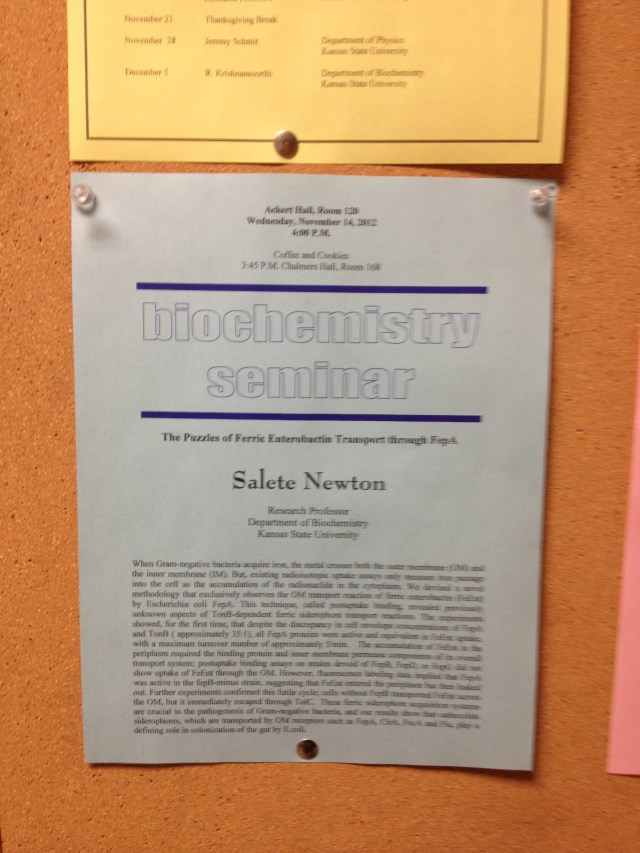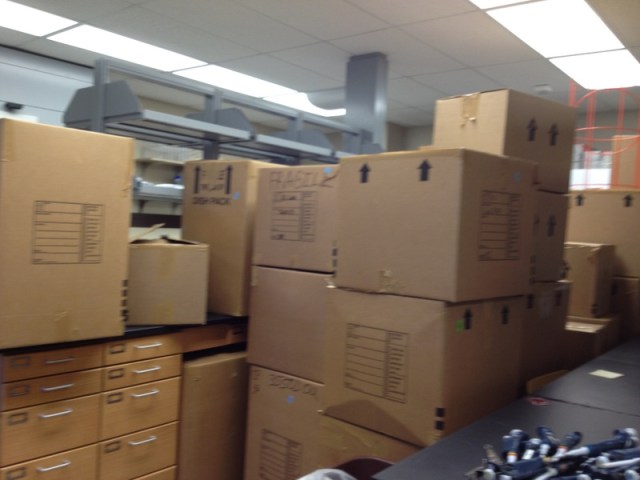L.I.T., you ask? Well, that stands for Laboratory of Iron Transport, and it’s where I spend most of my waking hours. In brief, we study how bacteria such as Escherichia coli and Listeria monocytogenes get iron from the environment and “swallow it up.” The metal is indispensable for bacteria as well as all other living organisms to survive, but it is very tricky to obtain. Iron can be compared to money in the sense that everyone who has it tries to protect it from being taken away. However, bacteria developed sophisticated systems to do just that: steal the iron from you and use it to survive. Since all pathogenic bacteria need to obtain iron to cause disease, we hope that our research will lead to the discovery of new weapons to fight infections.
We thought – actually, let me give full credit to Phil for that – he thought it would be fun to walk through the lab and ask what each person was doing, in an informal and fun way. Unfortunately, two of our undergrad students were not available when the video was made: Noah Long and Dallas Hyder. It was tricky enough to get everyone else there at the same time. I think the video turned out pretty good, as it was totally improvised.
Check it out here.
It makes me very sad to see Brittany Nairn, our super star Research Professor, getting ready to leave our group. She is the person who shows up in the video once Phil goes through a closed-door to our darkened “Fluorescence Spectroscopy Room.” We wish she could stay longer as a member of our team, but unfortunately that’s not possible. She will go on to write her own story, and we know she will be successful and happy no matter the path life takes her. Our whole lab will miss her terribly…
CREDITS IN ORDER OF APPEARANCE
Yan Shipelskiy – Graduate student working super hard to develop a full system of evaluation of iron uptake in Gram-positive bacteria
Olivia Eliasson – Undergrad student working with Dr. Nairn to evaluate compounds with anti-bacterial activity linked to blocking of iron uptake
Dr. Somnath Chakravorty – Post-doc who recently joined our lab, working on iron uptake genes from Klebsiella pneumoniae
Aritri Majumdar – Graduate student performing very tricky experiments to evaluate the effect of bacterial membrane integrity on iron uptake
Ashish Somvanshi – Graduate student who just joined our lab, also working on iron uptake by Klebsiella pneumoniae
Dr. Brittany Nairn – Research Professor who joined our lab in August last year, and developed from scratch a whole system to evaluate iron uptake in a pathogen called Acinetobacter baumannii
Dr. Sally Newton – yours truly, molecular biologist by day, food blogger by night. Performing her favorite type of experiment using radioactive iron. Because, you know… some like it hot!
Director, Producer and Narrator, Dr. Phillip Klebba… My favorite scientist in the whole wide world!
Our undergrad student Noah Long, missing from the video, but proudly showing the results of his labor: the best batch of enterobactin ever purified in our lab! How cool is that look?
😉
Before I leave, I invite you to watch this video of Dr. Phil Klebba explaining in more detail the research of our group. Sorry, ladies, he is already taken.







 Almost three months have gone by since we moved our lab from OU to KSU. I wish I had been able to compose a post about it sooner, but let’s just say that life has been tremendously busy ever since. Those who follow my blog might remember that our home move was a
Almost three months have gone by since we moved our lab from OU to KSU. I wish I had been able to compose a post about it sooner, but let’s just say that life has been tremendously busy ever since. Those who follow my blog might remember that our home move was a 









